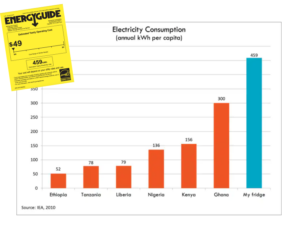Small policy fixes can have huge effects. Altering a government rule or launching a new initiative can suddenly change what’s possible. Or, with the stroke of a pen, unlock capital to save lives, create jobs, or strengthen national security. Ideas from independent research organizations help identify and inspire many of these changes. Yet think tanks and funders still grapple with how to show policy influence and impact in clear and compelling ways.
Think tanks’ core value is generating empirical evidence and ideas outside government. But impact only happens when people inside government are influenced by those ideas enough to change their thinking and decisions. How think tanks influence policy isn’t straightforward. Showing the influence and impact of our work isn’t either.
We’ve hit on one answer to this challenge that we think is worth sharing: the Energy for Growth Hub’s new impact and influence stories.
Policy impact is hard to measure simply.
As unabashed data nerds, it’s enticing for us to imagine a clear, quantitative calculation to show a rate of return. Put in X dollars and out come Y impacts. But our work is about influencing policy, which differs from efforts like investing (which provides a clear rate of return) or direct service delivery (which should provide a measure of outcomes like lives saved). Influencing policy isn’t direct, straightforward, or predictable. Understanding its complexity is central to articulating its impact.
Influencing policy is one piece of a bigger puzzle.
The Energy for Growth Hub imagines a world where no one’s potential is constrained by lack of electricity and where all economies have the energy they need to thrive. Like other nonpartisan think tanks, our work is about generating evidence (not ideological arguments) that can influence policy as a powerful way to make that world possible. We focus on global energy policies and financing rules that can enable cheaper, more reliable power — a foundation for creating jobs, climate resilience, and economic opportunities for millions of people. It’s a policy win for us when our research and ideas influence those decisions. But it’s just one piece of the puzzle that has to come together to reduce energy poverty and improve lives.

The late 1990s global debt campaign helps illustrate this, too. The goal was to reduce global poverty. The policy idea was canceling $100 billion of debt owed by dozens of poor countries to free up money for health and education. To do it, debt campaigners used their influence to seek changes in global financing rules so debt payments could be redirected to investments in people. When debt cancellation finally happened in 2000, it didn’t automatically help people. It was, however, a major policy win, dramatically boosting money for poor countries to spend — and ultimately helping reduce poverty and improve millions of lives.
Whenever we target policy changes, we still need to answer: so what? Policies aren’t the end of the story. We need to understand whether and how those changes make tangible differences in the long run. What think tanks and others pursuing policy impact can do better now is explain why we expect specific policy changes to make progress toward our goals, how we influence policy thinking and specific decisions, and when our work helps instigate specific changes.
Policy change is almost always non-linear.
You can’t plan A + B and expect C on a predetermined timeline. Too many people, politics, and shifting priorities exist to predict what will happen, when, and how. Instead, the most effective organizations position themselves so they’re known, trusted, and sought when the moment is right. Since the primary audience is policy insiders, it’s essential to have first-hand experience, cultivate a reputation for credible work that can be used quickly and easily, and pivot fast when dynamics change.
People smarts are hard to quantify.
Turning clever ideas on paper into policy change requires trusted relationships, empathy, and understanding the interests, incentives, and timelines of policymakers. It’s easy to track outputs (reports, memos, etc.). Tracking demand from policymakers for an organization’s ideas and expertise (e.g., invitations for input from senior officials or testifying to Congress) is more meaningful. Such events are not “big impact wins” themselves but they provide clear proxies for people smarts and signal the organization is well-positioned to shape fast-moving policy decisions. Organizations must maintain a relentless focus on what decision-makers need, when, and how to help move ideas through the maze of policy making.
Attribution is messy.
Rarely can one organization take all the credit for major policy wins. Wins almost always happen because of a confluence of events and circumstances. Like-minded organizations (and often strange bedfellows) come together to make progress. Credit for debt cancellation, for example, goes to think tank economists, treasury officials, multiple heads of state, UN officials, activist campaigners, rock stars, the pope, and many more. This is also why funders support a portfolio of grantees and not just one. Smart naming and branding of a new idea, like Advance Market Commitments for Vaccines, can show how it moves, but many others will be part of making it happen. Think tanks can share credit while tracking their specific contributions.
Complexity isn’t an excuse. Our response to the challenge.
We’re proud of what the Energy for Growth Hub has accomplished in our first five years and wanted to show it in ways that accurately reflect how our work influenced specific changes and deepen understanding of how independent research and ideas can lead to impact.
We’ve learned a lot from the Think Tank Initiative, and colleagues writing for the Hewlett Foundation, On Think Tanks, the American Enterprise Institute, and IDinsight. Our approach benefits from their insights and was greatly shaped by our joint experience at the Center for Global Development. One of us (Sarah Jane) joined the Hub in 2022 as our inaugural chief impact officer to push us to think bigger about how we track and share our impact.
Our influence and impact stories borrow elements of the World Resources Institute’s Top Outcomes and tips from Axios Smart Brevity. We’ve tried to explain what changed in the world with more on how we expect it to spur progress and who helped make it happen.
The core of how we define influence and impact: Other powerful people use our work to change policies and actions.
We design all of our work for leaders in government, finance, philanthropy, and advocacy. Their interests, incentives, and timelines drive what we do, how, and when. We track demand for our research and ideas and people, and when our work is cited by policymakers, journalists, advocates, and funders.
Our biggest stories of influence and impact are reserved for when other powerful people use our work to raise ambitions and change policies to end energy poverty. They include:
- A big idea happened. The US Development Finance Corporation (DFC) was created by Congress to provide up to $60 billion in financing for developing countries. The idea was first proposed by Energy for Growth Hub Founder Todd Moss and Hub Board Member Ben Leo and the legislation was based on their blueprint.
- A constraining rule was lifted. The DFC removed its ban on nuclear projects, expanding low-carbon energy options and investment opportunities, an idea pitched by the Hub and pushed forward with Third Way, ClearPath, and other allies.
- A new metric is helping to direct billions in new energy financing. Our Modern Energy Minimum is being used by the Global Energy Alliance for People and Planet in its core allocation for how to direct more than $10 billion of major new energy finance investments from philanthropists, government, local entrepreneurs, and the private sector.
- A concrete first step towards power contract transparency. Ghana launched a public register of power purchase agreements modeled on our contract disclosure proposal to boost competitive pricing, speed up clean energy deployment, and reduce debt risk.

- Myth-busting data and African perspectives are reshaping energy inequality solutions. Todd’s fridge graphic and Rose Mutiso’s TED Talks, podcast, and op-eds are shifting perspectives and the range of solutions, or the Overton window, for ending energy poverty.
We’re eager for feedback and advice on how we — and our peers — can capture and share impact that is accurate, true to what think tanks do, and help us all make faster progress. We’re thrilled several of our external partners mentioned in the stories are already using them for their own impact reporting and to build new opportunities, understanding, and alliances.
Please let us know what you think and send any feedback or suggestions to us at todd@energyforgrowth.org and sj@energyforgrowth.org.
Sarah Jane Staats is chief impact officer and Todd Moss is founder and executive director of the Energy for Growth Hub.



